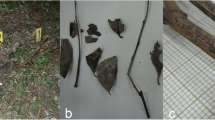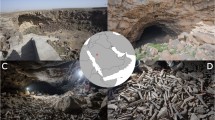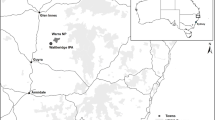Abstract
Cattle ranching is an important part of the heritage of the American West, yet few archaeological studies focus on this industry. Many aspects of ranching-related work are ephemeral, leaving on the landscape only small traces of these past activities. Survey on an historical ranch (established 1882) along the eastern escarpment of the Llano Estacado has identified a short-term cowboy camp at Macy Locality 16 (41GR722). Metal-detector survey and excavation has delineated camping activities alongside a chuck wagon and the remains of a temporary corral. Historical documents, composition of the site’s artifact assemblage, and its position on the landscape indicate the occupation was a ca. 1882–1901 roundup camp. This study demonstrates the importance of contextualizing ephemeral ranching-related sites within the broader organization of ranching activities across the landscape.
Extracto
La explotación ganadera es una parte importante del legado del Oeste americano, pero son escasos los estudios arqueológicos que se centran en ella. Muchos aspectos del trabajo ligado a la explotación ganadera son efímeros y dejan en el paisaje apenas pequeñas huellas de estas actividades del pasado. Un estudio de un rancho histórico (establecido en 1882) a lo largo de la escarpadura oriental de Llano Estacado ha identificado un campamento vaquero de corta duración en Macy Locality 16 (41GR722). Los estudios de detección de metales y las excavaciones han delineado actividades relacionadas con el campamento junto a un carromato y los restos de un corral provisional. Los documentos históricos, la composición del conjunto de artefactos del asentamiento y su posición en el paisaje indican que la ocupación fue un campamento de rodeo que data aproximadamente de 1882–1901. Este estudio demuestra la importancia de contextualizar los asentamientos ganaderos efímeros en el marco de la organización general de actividades ganaderas en el paisaje.
Résumé
L’exploitation bovine est un élément essentiel de l’héritage de l’Ouest américain cependant, peu d’études archéologiques portent sur ce secteur. De nombreux aspects des tâches connexes sont éphémères, ne laissant dans le paysage que quelques traces des activités passées. L’étude d’un ranch historique fondé en 1882 le long de l’escarpement est de Llano Estacado a permis d’identifier un camp bouvier temporaire à Macy Locality 16 (41GR722). Des travaux d’excavation et de détection de métaux ont permis de délimiter l’emplacement d’activités de camping à proximité d’un chariot de mandrin, ainsi que des vestiges de corral provisoire. Des documents historiques, l’assemblage des artefacts sur le site et leur positionnement dans le paysage indiquent une occupation de type camp de rassemblement datant de 1882–1901 environ. La présente étude démontre l’importance de contextualiser les sites éphémères dans le mode d’organisation plus vaste des activités d’exploitation bovine dans l’ensemble du paysage.











Similar content being viewed by others
Notes
The landowner wishes to remain anonymous.
References
Adams, Andy 1903 The Log of a Cowboy. Houghton, Mifflin Company, Boston, MA.
Adams, Ramon F. 1952 Come an’ Get It: The Story of the Old Cowboy Cook. University of Oklahoma Press, Norman.
Adams, Ramon F. 1961 The Old-Time Cowhand. University of Nebraska Press, Lincoln.
Adams, William H. 2002 Machine Cut Nails and Wire Nails: American Production and Use for Dating 19th- Century and Early-20th-Century Sites. Historical Archaeology 36(4):66–88.
Bennett, David, and David McGinnis 2008 Coupled and Complex: Human–Environment Interaction in the Greater Yellowstone Ecosystem, USA. Geoforum 39(2):833–845.
Bolton, Herbert E. 1921 The Spanish Borderlands: A Chronicle of Old Florida and the Southwest. Yale University Press, New Haven, CT.
Carrillo, Richard, Abbey Christman, and Roche Lindsey 2011 Cultural Resources Survey of the Purgatoire River Region. Manuscript, Colorado Preservation, Inc., Denver.
Carlson, Paul H. 2006 Myth and the Modern Cowboy. In The Cowboy Way: An Exploration of History and Culture, Paul H. Carlson, editor, pp. 1–10. Texas Tech University Press, Lubbock.
Clarke, Mary Whatley 1979 The Slaughter Ranches and Their Makers. Jenkins Publishing Company, Austin, TX.
Cox, James 1895 Historical Biographical Record of the Cattle Industry and the Cattlemen of Texas and Adjacent Territory. Woodward & Tiernan Printing Co., St. Louis, MO.
Cruse, J. Brett 2008 Battles of the Red River War: Archeological Perspectives on the Indian Campaign of 1874. Texas A&M University Press, College Station.
Didway, Charles (editor) 1980 Wagon Wheels: A History of Garza County. Eakins, Burnett, TX.
Dixon, Kelly J. 2014 Historical Archaeologies of the American West. Journal of Archaeological Research 22(3):177–228.
Engel, Paul M. 2012 Towards an Archaeology of Ranching on the Point Reyes Peninsula. Master’s thesis, Department of Cultural Resources Management, Sonoma State University, Rohnert Park, CA.
Erickson, John R. 2004 The Modern Cowboy. University of North Texas Press, Denton.
Faulk, Odie B. 1965 Ranching in Spanish Texas. Hispanic American Historical Review 45(2):257–266.
Fenneman, Nevin M. 1931 Physiography of Western United States. McGraw-Hill Book Company, New York, NY.
Fischer, John Ryan 2007 Cattle in Hawai‘i: Biological and Cultural Exchange. Pacific Historical Review 76(3):347–372.
Fischer, John Ryan 2008 Domesticating the Frontier: An Environmental History of the Conquest of California and Hawaii. Doctoral dissertation, Department of Geography, University of California, Davis. University Microfilms International, Ann Arbor, MI.
Fontana, Bernard L. 1967 The Archaeology of Post-18th Century Ranches in the United States. Historical Archaeology 1:60–63.
Fontana, Bernard L., J. Cameron Greenleaf, Charles W. Ferguson, Robert A. Wright, and Doris Frederick 1962 Johnny Ward's Ranch: A Study in Historic Archaeology. Kiva 28(1&2):1–115.
Gibson, Chris 2014 Cowboy Masculinities: Rationality and Rural Identity. In Masculinities and Place, Andrew Gorman-Murray and Peter Hopkins, editors, pp. 125–142. Ashgate, Farnham, UK.
Gosnell, Hannah, and William R. Travis 2005 Ranchland Ownership Dynamics in the Rocky Mountain West. Rangeland Ecology and Management 58(2):191–198.
Guyer, James S. 1938 Pioneer Life in West Texas. James S. Guyer, Brownwood, TX.
Haggerty, Julia H. 2004 A Ranchland Genealogy: Land, Livestock, and Community in the Upper Yellowstone Valley, 1866–2004. Doctoral dissertation, Department of History, University of Colorado, Boulder. University Microfilms International, Ann Arbor, MI.
Haley, J. Evetts 1936 Charles Goodnight: Cowman and Plainsman. University of Oklahoma Press, Norman.
Hardesty, Donald L. 1988 The Archaeology of Mining and Miners. Society for Historical Archaeology, Special Publication Series, Ann Arbor, MI.
Hardesty, Donald L., and Barbara J. Little 2009 Assessing Site Significance: A Guide for Archaeologists and Historians. Altamira Press, New York, NY.
Head, Lesley, and Richard Fullagar 1997 Hunter-Gatherer Archaeology and Pastoral Contact: Perspectives from the Northwest Northern Territory, Australia. World Archaeology 28(3):418–428.
Holden, William C. 1930 Alkali Trails, or, Social and Economic Movement of the Texas Frontier 1846–1900. Texas Tech University Press, Lubbock.
Holden, William C. 1932 Rollie Burns, or, an Account of the Ranching Industry on the South Plains. Texas A&M University Press, College Station.
Holden, William C. 1934 The Espuela Land and Cattle Company: A Study of a Foreign-Owned Ranch in Texas. Texas State Historical Association, Austin.
Holden, William C. 1970 The Espuela Land and Cattle Company: A Study of a Foreign-Owned Ranch in Texas. Texas State Historical Association, Austin.
Hough, Emerson 1897 The Story of the Cowboy. D. Appleton & Company, New York, NY.
Huntsinger, Lynn, and Peter Hopkinson 1996 Viewpoint: Sustaining Rangeland Landscapes: A Social and Ecological Process. Journal of Range Management 49(2):167–173.
Huntsinger, Lynn, and José L. Oviedo 2014 Ecosystem Services Are Social-Ecological Services in a Traditional Pastoral System: The Case of California’s Mediterranean Rangelands. Ecology and Society 19(1). Ecology and Society <https://www.ecologyandsociety.org/vol19/iss1/art8/>. Accessed 14 February 2018.
Iverson, Peter 1994 When Indians Became Cowboys: Native Peoples and Cattle Ranching in the American West. University of Oklahoma Press, Norman.
Jackson, Marsha 1976 Field Notes on the Excavation at XIT Headquarters. Manuscript, Museum of Texas Tech University, Lubbock.
Johnson, Eileen, and Vance T. Holliday 2004 Archeology and Late Quaternary Environments of the Southern High Plains. In The Prehistory of Texas, Timothy K. Perttula, editor, pp. 283–295. Texas A&M University Press, College Station.
Kersting, Dulce L. 2013 “In All Truthfulness as I Remember It”: Deciphering Masculinity in Cowboy Memoirs. Master’s thesis, Department of History, Washington State University, Pullman.
Kornfeld, Marcel 1983 A Model of High Plains and Intermountain Stockraising Settlement Systems. North American Archaeologist 4(1):51–62.
Langmuir, Eric 1984 Mountaincraft and Leadership. Scottish Sports Council/MLTB/Cordee, Leicester, UK.
Liles, Jeff 2008 A Historical Geographical Assessment of Bison Hunting on the Southern Great Plains in the 1870s. Master’s thesis, Department of Geography, Oklahoma State University, Stillwater.
Lyons, Nick 2008 Montgomery Ward & Co. Catalogue and Buyers’ Guide (1895). Sky Horse, New York, NY.
Maret, Elizabeth 1993 Women of the Range: Women’s Roles in the Texas Beef Cattle Industry. Texas A&M University Press, College Station.
Massey, Sara R. (editor) 2000 Black Cowboys of Texas. Texas A&M University Press, College Station.
Massey, Sara R. (editor) 2006 Texas Women on the Cattle Trails. Texas A&M University Press, College Station.
McAllister, Ryan R. J., Nick Abel, Chris J. Stokes, and Iain J. Gordon 2006 Australian Pastoralists in Time and Space: The Evolution of a Complex Adaptive System. Ecology and Society 11(2). Ecology and Society <https://www.ecologyandsociety.org/vol11/iss2/art41/main.html>. Accessed 14 February 2018.
McGrath, Ann 1987 Born in the Cattle: Aborigines in Cattle Country. Allen & Unwin Australia, Sydney, Australia.
Mills, Peter R., Carolyn L. White, and Benjamin Barna 2013 The Paradox of the Paniolo: An Archaeological Perspective of Hawaiian Ranching. Historical Archaeology 47(2):110–132.
Panich, Lee M., and Tsim D. Schneider 2015 Expanding Mission Archaeology: A Landscape Approach to Indigenous Autonomy in Colonial California. Journal of Anthropological Archaeology 40(1):48–58.
Parks, Aline, and Dudley Cramer (editors) 1986 Early Ranching in West Texas. Braum-Brumfield, Ann Arbor, MI.
Perkins, John, and Jack Thompson 1992 The Technology of Open-Range Cattle Farming in Early European Australia. Prometheus 10(1):113–127.
Porter, Kenneth W. 1969 Negro Labor in the Western Cattle Industry, 1866–1900. Labor History 10(3):346–374.
Robbins, Paul, Katharine Meehan, Hannah Gosnell, and Susan J. Gilbertz 2009 Writing the New West: A Critical Review. Rural Sociology 74(3):356–382.
Rock, James T. 1984 Cans in the Countryside. Historical Archaeology 18(2):97–111.
Rollins, Philip A. 1922 The Cowboy: His Characteristics, His Equipment, and His Part in the Development of the West. C. Scribner’s Sons, New York, NY.
Sabin, Ty J., and Vance T. Holliday 1995 Playas and Lunettes on the Southern High Plains: Morphometric and Spatial Relationships. Annals of the Association of American Geographers 85(2):286–305.
Sandoz, Mari 1958 The Cattleman: From the Rio Grande across the Far Marias. University of Nebraska Press, Lincoln.
Savage, William W., Jr. 1975 Cowboy Life. University of Oklahoma Press, Norman.
Sayre, Nathan F. 2007 A History of Working Landscapes: The Altar Valley, Arizona, USA: How Ranchers have Shaped the West and Continue to Do so. Rangelands 29(3):41–45.
Silliman, Stephen W. 2004 Lost Laborers in Colonial California: Native Americans and the Archaeology of Rancho Petaluma. University of Arizona Press, Tucson.
Slatta, Richard W. 1997 Comparing Cowboys and Frontiers. University of Oklahoma Press, Norman.
Taliaferro, Matthew S., Bernard A. Schriever, and M. Steven Shackley 2010 Obsidian Procurement, Least Cost Path Analysis, and Social Interaction in the Mimbres Area of Southwestern New Mexico. Journal of Archaeological Science 37(3):536–548.
Trolinger, J. Boyd 2006 Rodeo Cowboy: “Booger Red” Privett and the Origins of Rodeo. In The Cowboy Way: An Exploration of History and Culture, Paul H. Carlson, editor, pp. 155–166. Texas Tech University Press, Lubbock.
Vlahos, Ekaterini 2005 Preserving Ranches: Not only Possible, but Imperative. CRM: The Journal of Heritage Stewardship 2(1):6–12.
Vlahos, Ekaterini 2006 Preserving the Cultural Landscapes of Ranching in the American West. In Getting Real: Design Ethos Now, Renee Cheng and Patrick J. Tripeny, editors, pp. 437–443. Association of Collegiate Schools of Architecture, Washington, DC.
Wallace, Ernest 1964 Ranald S. Mackenzie on the Texas Frontier. Texas A&M University Press, College Station.
Walter, John 1999 The Guns that Won the West: Firearms on the American Frontier, 1848–1898. Stockpile, London, UK.
Ward, Dallas C. 2016 A Heritage Perspective on the Historic U-Lazy-S Ranch––a Case Study in Heritage Construction. Master’s thesis, Department of Museum Science, Texas Tech University, Lubbock.
Ward, Fay E. 1958 The Cowboy at Work: All about His Job and How He Does It. University of Oklahoma Press, Norman.
Webb, Walter P. 1931 The Great Plains. Grosset & Dunlap, New York, NY.
Wells, Tom 1998 Nail Chronology: The Use of Technologically Derived Features. Historical Archaeology 32(2):78–99.
Acknowledgments:
The authors thank the landowner for graciously allowing us access to the ranch. Thanks to Margaret Purser and several anonymous reviewers for their comments that have improved this manuscript. This research was funded by the Museum of Texas Tech University and a foundation that wishes to remain anonymous and represents part of the ongoing Lubbock Lake Landmark regional research into cultural landscape use strategies on the Llano Estacado.
Author information
Authors and Affiliations
Corresponding author
Rights and permissions
About this article
Cite this article
Hurst, S., Ward, D.C., Johnson, E. et al. Cowboy Life along the Llano Estacado Eastern Escarpment of Northwest Texas: Insights from Macy Locality 16 (41GR722). Hist Arch 52, 332–347 (2018). https://doi.org/10.1007/s41636-018-0098-7
Accepted:
Published:
Issue Date:
DOI: https://doi.org/10.1007/s41636-018-0098-7




